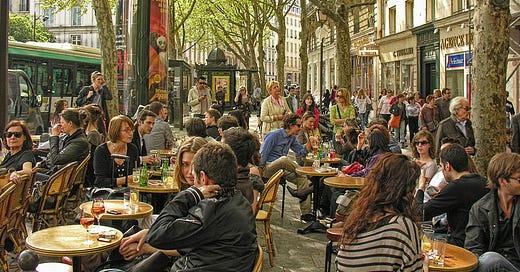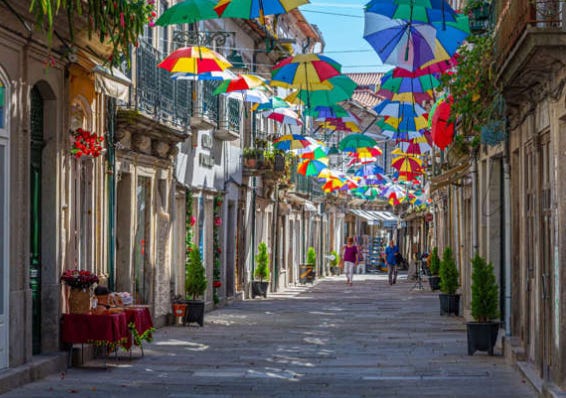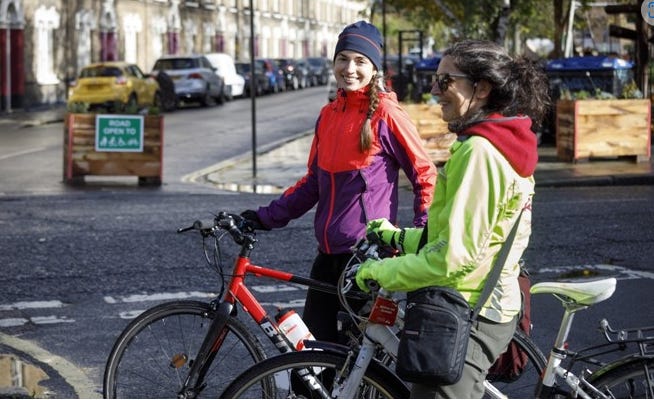Changing the Pace - Slowness and the City
Why slowing down the city can be an effective solution to many urban ills
Cities mean different things to different people. For some the hustle and bustle makes them places full of opportunities to explore and new ways of working and learning. It makes it possible meet people drawn to the city for various reasons and from diverse locations. City living can be the spur to innovation in economic activity, culture and lifestyles. For others, working in the city means long and often frustrating commutes from suburban residential districts. For still others city living is living on the margins, struggling to make ends meet and maintain a roof over their head.
Cities offer a fast-moving world in which progress is often seen in terms of making things faster still. Traffic engineers seek to make urban mobility quicker, on-line businesses seek to fulfil orders in ever shorter timeframes, food is prepared and often consumed on the go, and information flows ever faster in digital and social media. City thoroughfares are usually busy, bright and noisy. Shopping malls, entertainment complexes, transport interchanges, eating places all compete for customers as people go about their daily lives.
‘Third places’ within towns and cities – places which are not workplaces or residential areas – which offer opportunities for social contact and shared activities are important to residents.. Successful third places should facilitate opportunities for social interaction and exchange. However the very pace of city living is driving a recognition of the importance of spaces within them where the bustle can be paused. Third places like mini-parks, smaller public squares away from main thoroughfares can offer ‘time-out’ to relax, re-set and reflect on other matters. They offer a refuge from the pressures of the city and are vital to protect and enhance urban livability and quality of life.
Place and time
The pace of city life is determined by many factors – the built environment, the speed and efficiency of urban transportation, the technologies that connect people to places and activities. Cities provide an environment for people to move around, communicate and interact with others, and explore different spaces. Spaces within cities have a time dimension associated with them. Some are perceived as ‘fast’ because they form hectic hubs of activity where everyday life is performed in a hurried and restless way. Other places are ‘slow’ because movement and social activities are more calm and leisurely. These are what Wunderlich refers to as the ’place-rhythms’ of everyday city spaces. Although determining clear causal relationships between physical space and wellbeing can be difficult physical space influences how we interact with it and emotionally relate to it. Places come to have different aesthetics depending on the pace and urban environment: they may be seen as fast or slow, restless or calm or surprising or predictable.
The ‘slow movement’
‘Slow’ approaches have grown up as a kind of antidote to aspects of modern living and ‘place-rhythms’ deemed to be unhealthy or superficial: ‘slow reading’ encourages readers to take time to reflect on what they are reading rather than skimming or scrolling rapidly through short texts whilst the ‘slow food’ movement emphasizes local food production and traditions to the exclusion of multi-national homogeneity of food production. Inspired by the slow food movement came the ‘slow city’ concept now promoted by an international organization ‘Cittaslow’ originally founded in 1999 in Orvieto in Italy and now with over approaching 100 member cities in a growing number of countries around the world.
The slow city movement emphasizes the importance of maintenance of local character whilst developing an economy capable of sustaining communities into the future. The Slow City aims to protect and enhance urban liveability and quality of life. Slow Cities are places where citizens and local leaders pay attention to local history and utilize the distinct local context to develop in better and more sustainable ways. The focus is on local distinctiveness to create an alternative, more inclusive, less corporate-centred urban regime which explicitly links the economy, the environment and equity.
Cittaslow has provided member cities with a detailed set of policy guidelines which focus on providing green space, accessible infrastructure, internet connectivity, promoting renewable energy and sustainable transport, and being welcoming and friendly to all. By reducing pollution, traffic and crowds and promoting better social interaction within communities, slow cities seek to create opportunities for healthier behaviour patterns – including pausing and slowing down.
Cittslow membership is only available to smaller towns and cities with a population of 50,000 or less. Nevertheless some much larger cities are seeking to adopt some similar principles in their urban planning. Slow London is a good example.
Faster is not always better
The conventional wisdom is that the quicker things are done the more efficient life becomes. Whilst this may be true for many businesses, the assumption that it is also true for liveability and the quality of life is more questionable. For example, the assumption that if urban transportation enables people to reach their destinations quicker then time is saved. Increasing speed can encourage urban sprawl which in turn leads to longer travel times and longer working hours. It is one of the paradoxes of modern times that the faster we go, the less time we have.
At the same time speed is associated with many more problematic issues for urban living such as increased road deaths and injuries, air pollution, high infrastructure costs and energy consumption, and climate impacts. Current models of urban planning based on speed are likely to be unable to address zero carbon emissions and environmental concerns.
For businesses and services speed can be vital for efficiency and productivity, but people do not always need to be fast to be productive or to lead quality life-styles. Planning strategies for well-being and the quality of life in cities should not associate speed with efficiency alone, but embrace many elements which already feature in some cities’ future development planning. Numerous cities have demonstrated the feasibility of lowering speed limits and introducing low traffic zones, re-allocating street space to provide more social interaction and alternative modes of travel, and revising land-use planning to promote walkability and local living. Some cities have been able to eliminate road deaths and substantially reduce air pollution, and many report significant improvements in business revenues in city centres.
Pace and placemaking
I have argued in an earlier piece here that placemaking is in danger of being over-sold and under-achieving as developers use ‘placemaking’ to turn often uninspired residential stock into ‘vibrant communities’ or ‘liveable neighbourhood’ or claims to breathe new life into re-furbished spaces. Such ‘fast’ placemaking runs the risk of ‘cookie-cutter’ placemaking, copying what has worked elsewhere and ignoring the more organic processes of community-based placemaking. Pop-up placemaking and tactical urbanism risk undermining the notion of place even further.
Good practice in placemaking is based on deep collaboration with communities over time so that places evolve in ways which meet a community’s changing needs. Placemaking seeks to develop a close relationship between people and their locale. It should lead to spaces which are unique to the particular community setting. It is essentially ‘slow’: places are never finished, and good places which offer rich social interaction are likely to be essentially slow spaces.
Pace and active travel
Encouraging more active travel – usually walking or cycling – for local journeys has become an important priority for many cities. It is an important contributor to improved public health and air quality, increased road safety, better street life and reduced carbon emissions. It is also a measure that can reduce car use and traffic congestion which can have the effect of increasing the speed of urban travel.
Whilst it would normally be true that travel on foot or by bicycle would be slower than by public transport or car, in urban environments studies have shown that this is not inevitably the case. The accessibility and convenience achieved by walking and cycling helps to compensate for the lower average speed of these modes of travel. Cycling can have a (slightly) lower journey time than trips by bus. Walking and cycling offer efficient means of transport in their own right. They are affordable, can move large numbers of people in a small amount of space, rely on relatively cheap infrastructure and, in the right conditions, offer very competitive travel times.
There are also benefits to the urban realm. Walking and cycling can increase the productive use of space, can boost town and city trade through allowing the development of more attractive places, and in turn, the characteristics of the urban realm can increase the level of walking and cycling. Counter-intuitively, encouraging apparently ‘slower’ modes of transport can bring increased efficiencies to urban mobility, increased accessibility to businesses and to social and cultural opportunities and gains to individual and public health.
Pace and the smart city
The increasing application of smart technology and AI in urban settings is usually seen in the context of efforts to improve the efficiency of public services, improve traffic flows and journey times for public transport and commuters, and deliver social services more rapidly and efficiently. However as technology advances it is clear that smart technologies and purposeful use of data can also improve many aspects of the quality of life and liveability in cities. Accounts of Innovative smart-city applications demonstrates they can positively affect time and convenience, safety, public health and health care, social connectedness, civic participation, employment and environmental quality.
Many smart applications have the aim of making cities faster. It is estimated that smart-mobility applications have the potential to reduce commuting time in cities with well-developed public transport by up to 20% and save the average commuter 15 minutes a day and twice that in sprawling cities with longer commutes. Intelligent synchronizing of traffic lights can reduce average commutes by 5% in cities where many people travel by bus. Parking apps can avoid wasted time in search for vacant parking space.
But making these time-savings begs questions about what might be done with that freed-up time and ensure that time saved is time well spent. Tranter and Tolley suggest that instead of prioritizing planning for mobility (how far can you go in a given time), urban planning should be about accessibility (how much can you get to in that time). They argue that accessibility-rich places do not need speed: walking and cycling can be appropriate modes of travel and cities can slow down to concentrate on quality-of-life issues. Arguably cities should be smart and slow.
Slowness as a strategy
In a culture that values speed and efficiency, planning for slowness might not be an obvious strategy to adopt, but as we have seen above, there is growing evidence for a ‘slowness dividend’. As we have seen more familiar concepts in urban planning such as placemaking, the promotion of walkability and active travel and extending the application of smart technologies beyond behind-the-scenes service efficiencies, can all contribute to this slowness dividend arising from improved health, better air quality, less traffic disturbance and improved safety.
There is a theory first put forward in 1975 by geographer Jay Appleton that humans have evolved to crave both prospect (or opportunity) and refuge (or safety). When applied to cities, when people are out and about they are prospecting and looking for opportunities and things that are new and interesting. It is less clear however what cities can offer by way of refuge. Slow spaces are vital and for many the path to refuge and to physical and mental wellbeing.
But these strategies towards slowness themselves need to be implemented slowly. An emphasis on slowness represents a re-balancing of the relationship between economy, environment and equity. Many cities remain driven by business and economic interests which may be external to the city as evidenced by the preponderance of large shopping malls, homogeneity in retail offers and food outlets, and extensive car-parking to enable easy access to these facilities. Slow cities on the other hand rest on an alternative model which stresses economic localism, environmental concerns and more inclusive access to community assets. Whether, at the city level, such an alternative model can drive a city-wide change in urban development is problematic, but whatever development model is followed, every city can incorporate elements of slowness and reap benefit for its residents. As Tranter and Tolley put it, ‘if you want your city to be healthier, happier, safer, wealthier, less unequal, more child-friendly and resilient, just slow it down’.
Some other pieces on Policies for Places which may be of interest to you:
Streets, publicness and the Public Realm
Building Placeness: Is Placemaking Over-promising and Under-delivering?









You are reading my mind... planners too often think it imperative to work fast, get approvals, move on. Well done!